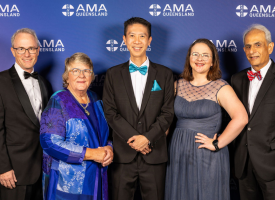AMA issues blueprint to support medical students and doctors with disability
The Australian Medical Association is urging key organisations in the health sector to play a much greater leadership role by developing and embedding pathways that support a career in medicine for people with disability.

With a firm focus on inclusion, a new position statement from the AMA recognises disability as an essential form of diversity and outlines areas where organisations, employers, medical schools and colleges need to take action to avoid barriers to participation in medicine.
Medical students and doctors with a disability, including those who have acquired a disability during training or as a fellow, report a variety of barriers beginning with entry into medical school and persisting throughout medical training to fellowship and into employment.
Supporting doctors and medical students with disability 2023 outlines actions needed to create inclusive training and work environments in key areas of fair selection, organisational support, flexibility and research.
AMA President Professor Steve Robson said while one in six Australians had a disability, this was not reflected in the numbers of doctors or trainee doctors with a disability.
“The AMA has taken this position to ensure that the health sector is set up for inclusivity, and to encourage and retain doctors and trainees with a disability into the profession.
“We need to ensure our own system breaks down the many barriers people with disability face, such as preconceived attitudes and bias about ability and varying approaches to application processes for selection into training.”
Professor Robson said pathways to careers in medicine should adopt a strengths-based approach, focusing on abilities, knowledge and capacities rather than deficits.
“While work has been done in a variety of areas, there is more to do to embrace inclusivity, reduce discrimination and ensure policy and process has a practical and tangible impact supporting people with disability pursue their medical career,” he said.
Professor Robson also acknowledged there was limited information available about what steps employers and training providers could take to accommodate individuals with disability.
“The AMA position statement provides this blueprint and we see enormous value in collating case studies and examples of good practice as part of the development of guidance to support people who acquire a disability to practise medicine,” Professor Robson said.
AMA member and co-founder of Doctors with Disability Australia, Dr Dinesh Palipana, said building an environment where there was trust that disclosure of a disability would be treated with respect and from a strengths-based perspective was essential.
“Providing accessible information and resources demystifying mandatory reporting and other processes can prevent individuals with disability from being discouraged to seek support for fear of repercussions, discrimination, restricted from practice or reported,” Dr Palipana said.
“For me, coming back to medical school, and then becoming employed as a doctor after a spinal cord injury, and later pursuing specialist training was challenging and at times heart-wrenching.
“Disability inclusion increases our profession’s understanding of the experience and needs of so many Australians who have disability, benefiting both patients and the profession. But, there’s even more to it than that; research has demonstrated that a diverse workforce improves innovation and performance, and for a health system under pressure, this is a win-win scenario,” Dr Palipana said.
Other recommendations in the new AMA policy include providing information and education at all levels to improve the understanding of workplace law relating to disability.



